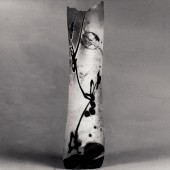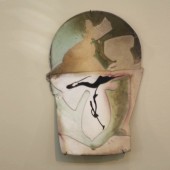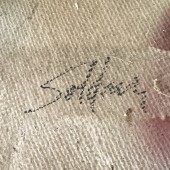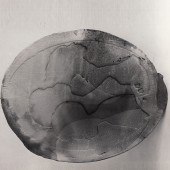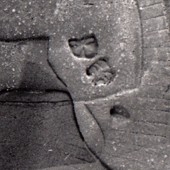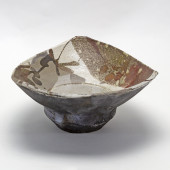![]() Printer version
Printer version
Paul E. Soldner
1921Born Summerfield, Illinois
2011Died Claremont, California
EDUCATION
1946BS Art Education, Bluffton College, Ohio
1954MS in Arts Administration, University of Colorado, Boulder, Colorado
1956MFA Los Angeles County Art Institute (now Otis Art Institute), Los Angeles, California
PRIMARY WORK EXPERIENCE
1956-1993Faculty, Department Head, Ceramics, Scripps College and the Claremont Graduate School, Claremont, California
1967-1968Professor of Ceramics, University of Iowa, Iowa City, Iowa
1966-1967Professor of Ceramics, University of Colorado, Boulder, Colorado
1968Co-founder, Anderson Ranch Arts Center, Snowmass, Colorado
BIOGRAPHY
Paul Soldner is known for his raku fired vessel forms, monumental ‘Floor Pots’ and his technological contributions to the field of ceramics.
Most famously, he developed American Raku. While this process is most commonly understood as a low-fired, smoked ceramic ware, Soldner defined it as an evolving art form and an understanding of the medium beyond a particular specified method.
In addition, he was known for his salt-vapor bisque firing technique and, patented innovations including Soldner Potter’s Kick Wheel, Soldner Electric Potter’s Wheel and Soldner Clay Mixer. Soldner was one of Peter Voulkos’ first students at the Los Angeles County Art Institute (now Otis). At the time, the Ceramics studio consisted of a sink and a table. As the sole graduate student, Soldner played a large role in helping Voulkos design and build the space. Voulkos' expressionistic style influenced Soldner's ceramics and, the experience of building the studio let to Soldner’s continued interest in developing new ceramic technologies and methods.
Soldner’s early works are based on the vessel form, usually a tea bowl. He was one of the few vessel makers in the program. Throughout his career, Soldner made work using only a single method, slab built or wheel thrown, or by a combination of both methods starting with a wheel thrown form. He typically used a mixture of plastic fireclay, Kentucky ball clay (OM 4), red clay and sand when low-fire salt fuming. To create surface decoration, Soldner would apply thin colored slips with a brush, evoking both calligraphy and watercolor. Occasionally, he used paper resist stencils depicting human, animal or botanical motifs that seem to dance around his pots.
One of Soldner’s most characteristic bodies of work are his plaques. These are made from plywood templates, onto which he laid burlap-backed flattened sheets of clay. He, then, would step on the clay to create an impression, turning the clay and repeating the process to create the desired effect. Each plaque was then dried in a custom, shallow bowl filled with sand to create a concave back.
In 1968 he founded the Anderson Ranch Arts Center in Snowmass, Colorado.
An interview with Paul Soldner conducted April 27 and 28, 2003 by Mija Riedel, for the Archives of American Art's Nanette L. Laitman Documentation Project for Craft and Decorative Arts in America is available at:
www.aaa.si.edu/collections/interviews/oral-history-interview-paul-soldner-12457.
PUBLIC COLLECTIONS
Alfred Ceramic Art Museum, Alfred University, Alfred, New York
Australian National Gallery, Sydney, Australia
Bluffton College Centennial Sculpture Garden, Bluffton, Ohio
Charles H. MacNider Art Museum, Mason City, Iowa
Chubb Insurance Company Corporate Collection, New York, New York
Coca Cola Corporate Art Collection, Atlanta, Georgia
Everson Museum of Art, Syracuse, New York
Fine Arts Museum of the South, Mobile, Alabama
Florida Keys Community College Library Collection, Key West, Florida
Franz Hals Museum, Amsterdam, Holland
Fred Jones Jr. Museum of Art, University of Oklahoma, Norman, Oklahoma
Gardiner Museum of Ceramic Art, Toronto, Ontario, Canada
Johnson Wax Corporate Art Collection, Racine, Wisconsin
Los Angeles County Museum of Art, Los Angeles, California
Museum of Arts and Design, New York, New York
National Museum of Modern Art, Kyoto, Japan
Oakland Museum of California, Oakland, California
Racine Art Museum, Racine, Wisconsin
Ruth Chandler Williamson Gallery, Scripps College, Claremont, California
Seattle Art Museum, Seattle, Washington
Smithsonian American Art Museum, Renwick Gallery, Washington, D.C.
Speed Art Museum, Louisville, Kentucky
State Museum of Fine Art, Riga, Latvia
Taipei Fine Arts Museum, Taipei, Taiwan
US News and World Report Corporation Art Collection, Washington, D.C.
Racine Art Museum, Racine, Wisconsin
University of Iowa Museum of Art, Iowa City, Iowa
BIBLIOGRAPHY
Andrews, Tim. Raku, A Review of Contemporary Work. Radnor, PA: Chilton Book Co., 1994.
Burkett, Richard and Glenn Nelson. Ceramics: A Potter's Handbook, 6th ed. Norwalk, CT: De Harcourt College Publishers, 2002.
Clark, Garth. A Century of Ceramics in the United States 1878-1978 – A Study of its Development. New York, NY: Dutton Adult, 1979.
De Wall, Edmund. Twentieth Century Ceramics. London, England: Thames & Hudson, 2003.
MacNaughton, Mary. Paul Soldner: Retrospective. Claremont, CA: Claremont Colleges, 1992.
Peterson, Susan. Working with Clay. London, England: Laurence King Publishing, 2002.
Soldner, Paul. “Low--‐Fire--‐Salt Fuming.” Ceramics Monthly, April 1995.
_______, Paul. “Without Laws.” Ceramics Monthly, May1992.
_______, Paul. “American--‐Style Raku.” Ceramic Review 124, (1990).
_______, Paul. Nothing to Hide: Exposures, Disclosures, & Reflections. Waterford, VA: Clay Times, Inc., 2011.
Welsh, Stan. American Ceramic Arts Today. San Jose, CA: San Jose State University, 1997.
Zakin, Richard. Ceramics-Mastering the Craft, 2nd ed. New York, NY: Oswego, 2003.
CV or RESUME: Click Here to Download
Source: Elaine Levin Archive, University of Southern California
CV or RESUME: Click Here to Download
Source: Elaine Levin Archives, University of Southern California
Citation: "The Marks Project." Last modified August 23, 2024. http://www.themarksproject.org:443/marks/soldner














